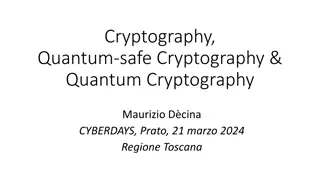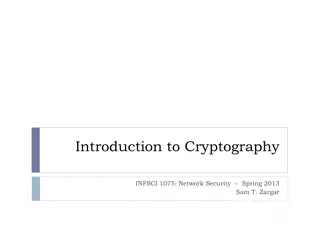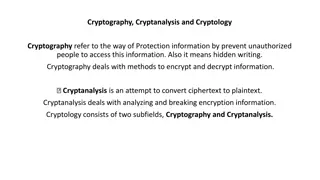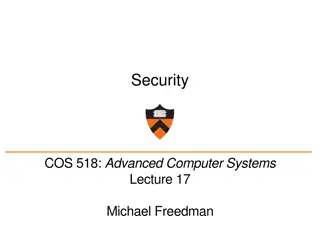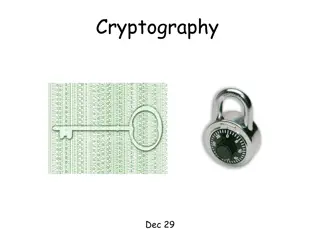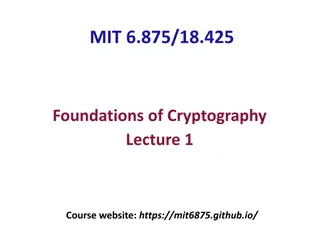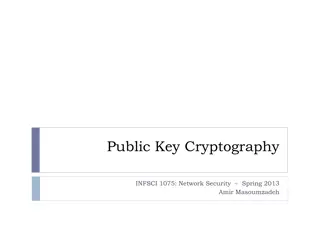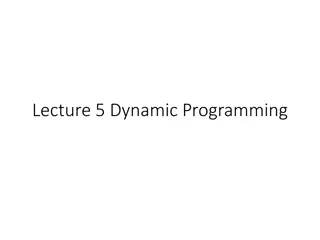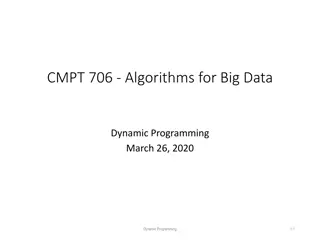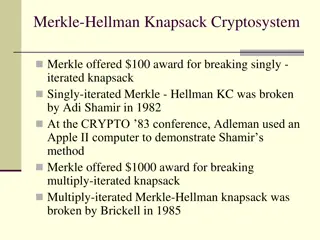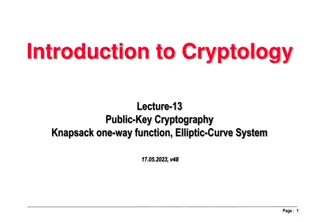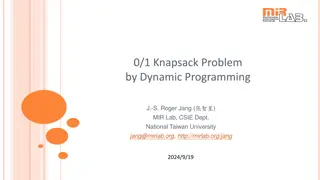The Knapsack Problem and Cryptography
The knapsack problem involves finding a subset of weights that sums up to a given value. It can be applied in cryptographic systems, where superincreasing knapsacks are easier to solve than general knapsacks. The knapsack cryptosystem utilizes superincreasing knapsacks for encryption and conversion to general knapsacks for decryption. However, the system has vulnerabilities, as shown by its weakness in the face of lattice reduction attacks.
Download Presentation

Please find below an Image/Link to download the presentation.
The content on the website is provided AS IS for your information and personal use only. It may not be sold, licensed, or shared on other websites without obtaining consent from the author.If you encounter any issues during the download, it is possible that the publisher has removed the file from their server.
You are allowed to download the files provided on this website for personal or commercial use, subject to the condition that they are used lawfully. All files are the property of their respective owners.
The content on the website is provided AS IS for your information and personal use only. It may not be sold, licensed, or shared on other websites without obtaining consent from the author.
E N D
Presentation Transcript
Knapsack Problem Given a set of n weights W0,W1,...,Wn-1 and a sum S, find ai {0,1} so that S = a0W0+a1W1 + ... + an-1Wn-1 (technically, this is the subset sum problem) Example Weights (62,93,26,52,166,48,91,141) Problem: Find a subset that sums to S = 302 Answer: 62 + 26 + 166 + 48 = 302 The (general) knapsack is NP-complete Part 1 Cryptography 1
Knapsack Problem General knapsack (GK) is hard to solve But superincreasing knapsack (SIK) is easy SIK each weight greater than the sum of all previous weights Example Weights (2,3,7,14,30,57,120,251) Problem: Find subset that sums to S = 186 Work from largest to smallest weight Answer: 120 + 57 + 7 + 2 = 186 Part 1 Cryptography 2
Knapsack Cryptosystem 1. 2. 3. 4. Generate superincreasing knapsack (SIK) Convert SIK to general knapsack (GK) Public Key: GK Private Key: SIK and conversion factor Goal Easy to encrypt with GK With private key, easy to decrypt (solve SIK) Without private key, an intruder has no choice but to try to solve GK o o o Part 1 Cryptography 3
Example Start with (2,3,7,14,30,57,120,251) as the SIK Choose m = 41 and n = 491 (m, n relatively prime, n exceeds sum of elements in SIK) Compute general knapsack 2 41 mod 491 = 82 3 41 mod 491 = 123 7 41 mod 491 = 287 14 41 mod 491 = 83 30 41 mod 491 = 248 57 41 mod 491 = 373 120 41 mod 491 = 10 251 41 mod 491 = 471 General knapsack: (82,123,287,83,248,373,10,471)
Knapsack Example Private key:(2,3,7,14,30,57,120,251) m 1 mod n = 41 1 mod 491 = 12 Public key:(82,123,287,83,248,373,10,471), n=491 Example: Encrypt 10010110 82 + 83 + 373 + 10 = 548 To decrypt, use private key 548 12 = 193 mod 491 Solve (easy) SIK with S = 193 Obtain plaintext 10010110
Knapsack Weakness Trapdoor:Convert SIK into general knapsack using modular arithmetic One-way: General knapsack easy to encrypt, hard to solve; SIK easy to solve This knapsack cryptosystem is insecure Broken in 1983 with Apple II computer The attack uses lattice reduction General knapsack is not general enough! This special case of knapsack is easy to break
RSA Invented by Clifford Cocks (GCHQ) and Rivest, Shamir, and Adleman (MIT) RSA is the gold standard in public key crypto Let p and q be two large prime numbers Let N = pq be the modulus Choose e relatively prime to (p 1)(q 1) Find d such that ed = 1 mod (p 1)(q 1) Public key is (N,e) Private key is d
RSA Message M is treated as a number To encrypt M we compute C = Me mod N To decrypt ciphertext C, we compute M = Cd mod N Recall that e and N are public If Trudy can factor N = pq, she can use e to easily find d since ed = 1 mod (p 1)(q 1) So, factoring the modulus breaks RSA Is factoring the only way to break RSA?
Does RSA Really Work? Given C = Me mod N we want to show that M = Cd mod N = Med mod N We ll need Euler s Theorem: If x is relatively prime to n then x (n) = 1 mod n Facts: 1) ed = 1 mod (p 1)(q 1) 2) By definition of mod , ed = k(p 1)(q 1) + 1 3) (N) = (p 1)(q 1) Then ed 1 = k(p 1)(q 1) = k (N) So, Cd = Med = M(ed 1) + 1 = M Med 1 = M Mk (N) = M (M (N))k mod N = M 1k mod N = M mod N
Simple RSA Example Example of textbook RSA Select large primes p = 11, q = 3 Then N = pq = 33 and (p 1)(q 1) = 20 Choose e = 3 (relatively prime to 20) Find d such that ed = 1 mod 20 We find that d = 7 works Public key:(N, e) = (33, 3) Private key:d = 7
Simple RSA Example Public key:(N, e) = (33, 3) Private key: d = 7 Suppose message to encrypt is M = 8 Ciphertext C is computed as C = Memod N = 83 = 512= 17 mod33 Decrypt C to recover the message M by M = Cd mod N = 177 = 410,338,673 = 12,434,505 33 + 8 = 8 mod 33
More Efficient RSA (1) Modular exponentiation example 520 = 95367431640625 = 25 mod 35 A better way: repeated squaring o 20 = 10100 base 2 o (1, 10, 101, 1010, 10100) = (1, 2, 5, 10, 20) o Note that 2 = 1 2, 5 = 2 2 + 1, 10 = 2 5, 20 = 2 10 o 51= 5 mod 35 o 52= (51)2 = 52 = 25 mod 35 o 55= (52)2 51 = 252 5 = 3125 = 10 mod 35 o 510 = (55)2 = 102 = 100 = 30 mod 35 o 520 = (510)2 = 302 = 900 = 25 mod 35 No huge numbers and it s efficient!
More Efficient RSA (2) Use e = 3 for all users (but not same N or d) + Public key operations only require 2 multiplies Private key operations remain expensive - If M < N1/3 then C = Me = M3 and cube root attack - For any M, if C1, C2, C3 sent to 3 users, cube root attack works (uses Chinese Remainder Theorem) Can prevent cube root attack by padding message with random bits Note: e = 216 + 1also used ( better than e = 3)


